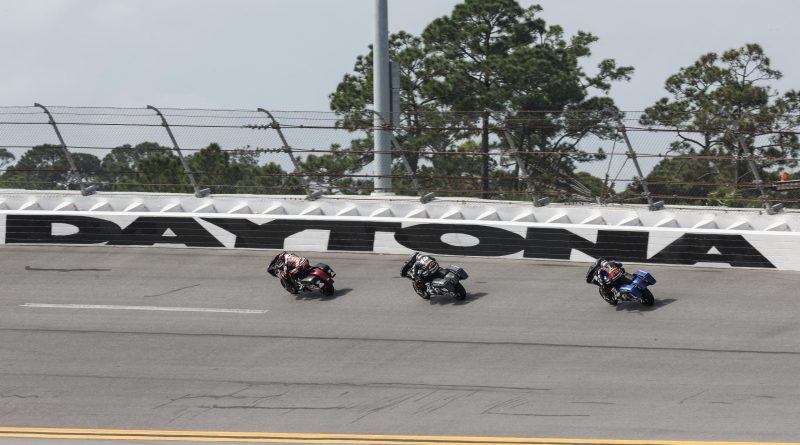The Science Of Speed: Daytona’s High Banks
Tires, momentum, and centripetal force all come into play on the high banks at Daytona International Speedway. Photo by Brian J. Nelson.
The history of Daytona International Speedway began in 1953 when Bill France Sr. realized the days of racing on the beach were numbered due to the spreading land usage caused by a rapidly growing population. On April 4, 1953, France put his plans into motion for the future of racing in Daytona Beach, Florida, with a proposal to construct a permanent speedway facility. On August 16, 1954, France signed a contract with the City of Daytona Beach and Volusia County officials to build what would become Daytona International Speedway, the “World Center of Racing.” In 1957, land clearing began for the Speedway.
The famous 31-degree high banks were included in the design of the track right from the very beginning so that higher speeds could be achieved and to make it easier for fans to see the motorcycles (and cars) race around the 2.5-mile tri-oval. The dirt for the banking was taken from the infield and resulted in the 29-acre space that is known as Lake Lloyd.
Now, 31 degrees may not sound like much, but when you enter the infield at Daytona International Speedway for the very first time, those high banks stand as towering testaments to speed. And, as you get closer to the banking, you go from being awestruck to literally having your breath taken away, especially if you stand on the flat apron at the bottom of the banking and walk up the steep incline towards the outer wall.
Those high banks, plus the large-radius turns, are what put the “speed” in Daytona International Speedway.
On a flat racetrack, the lean angle of a motorcycle and the contact patch of the tires have to do all the work. But, on the banking at Daytona, centripetal force is exerted on the bike, which greatly amplifies the turning force of the tires.
Centripetal force causes a body to follow a curved path. The direction of the centripetal force is always orthogonal (perpendicular) to the motion of the body and towards the fixed point of the instantaneous center of curvature of the path. Isaac Newton described it as “a force by which bodies are drawn or impelled towards a point as to a center.”
At Daytona, as stated, the degree of the banking is 31 degrees and the width of the track is 40 feet. Using that information, a bit of mathematics is needed to figure out the rest. In fact, it’s trigonometry, and who doesn’t love trigonometry? Me, for one, because I personally failed that subject in high school. But, I digress.
The sine of an angle is the ratio of the side of the track opposite the angle to the width of the track surface (aka: the hypotenuse of the triangle). The cosine is the ratio of the side of the track next to the angle to the width of the track surface.
Calculating opposite side = track width * sin(31), we determine that the rise is 20.6 feet. Then, calculating adjacent side = track width * cos(31) is 34.2 feet.
In other words, the banking is such that, for every foot you go over, you go up a little more than six inches.
For comparison purposes, the slope of a typical stairway is between 30 and 35 degrees. So, in essence, the steepness of the banking at Daytona is about the same as a stairway without any stairsteps. It’s also a little bit steeper than the slope of a 7/12-pitch roof, which is considered to be steep by modern construction standards.
So, on March 9-11, when you watch the MotoAmerica series at Daytona International Speedway in person and/or on MotoAmerica Live+ , including the 81st running of the Daytona 200, you’ll know the science (and math) behind all those beautiful bikes ripping around the high banks.
For the full 2023 MotoAmerica schedule and to purchase tickets for MotoAmerica events, click HERE
For information on how to watch the MotoAmerica series, click HERE
The post The Science Of Speed: Daytona’s High Banks appeared first on MotoAmerica.




